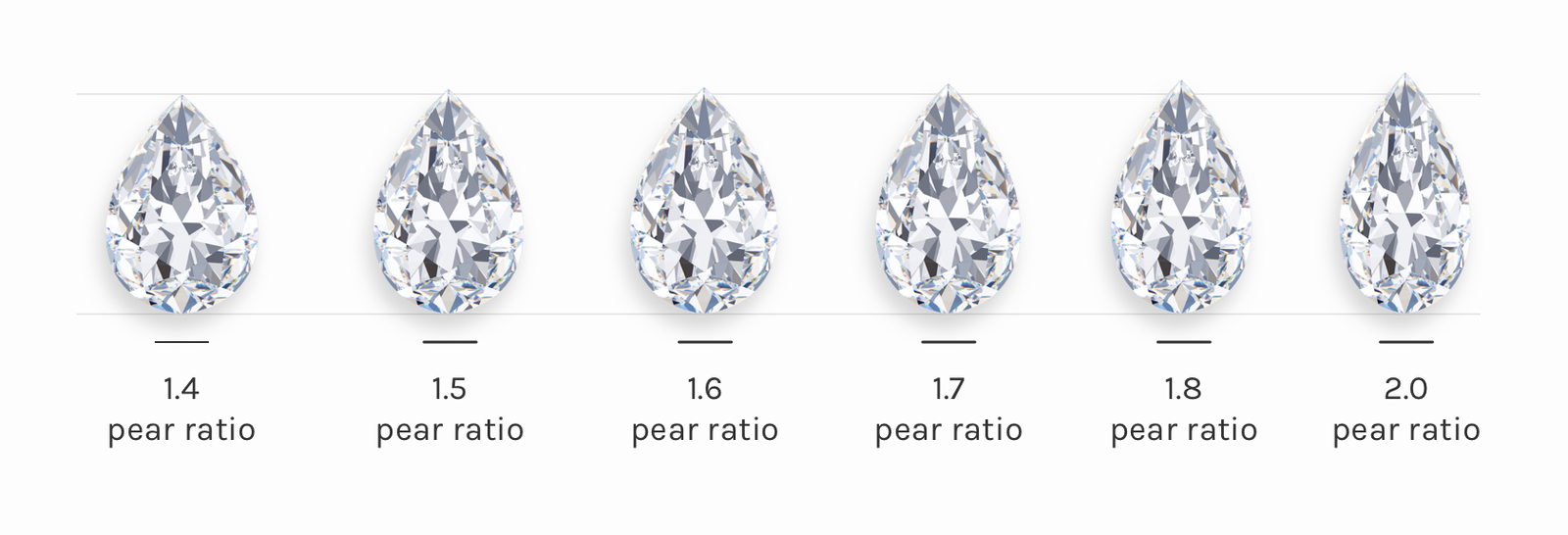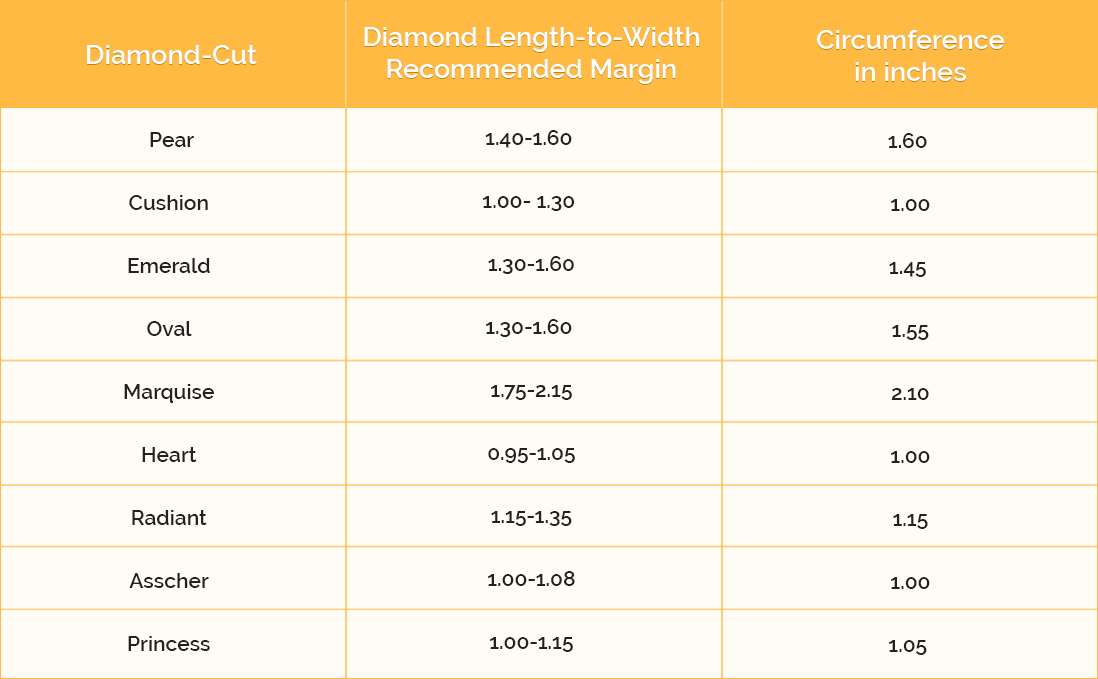Diamond Education
What Is The Best Length To
Width Ratio For A Diamond?
The length-to-width ratio is the length of the diamond divided by its width. It provides both you and the jeweler with an accurate sense of scale and how long the elongation of the diamond is.The diamond length/width ratio also defines the value of the gem. Alongside the 4C’s – Cut, clarity, carat, and color – the width ratio helps price your diamond. The width ratio defines the diamond’s brilliance, reflection potential, and general attractiveness.
The best length-to-width ratio for a diamond is around 1.32. This ratio is perfectly balanced and well-shaped. However, the ideal length-to-width ratio depends on both the shape of the stone and personal preference.
This article will explain how to identify length-to-width ratios and examine the most popular sizes to help you pick the perfect engagement ring.
How to calculate length/width ratios of your diamond
To calculate the length/width ratio of a diamond, divide the length of the gem by its width. The first two dimensions provided by the diamond’s GIA certificate will be its length and its width.
If your ring had a length of 5.55mm and a width of 5.40mm, the length-to-width ratio would be 1.02.
The base ratio of a ring is 1.0, which would suggest that the ring is completely symmetrical. The higher the ratio diverges from this base number, the more angled the diamond will be.
Elongated rings are often desirable to gem buyers, as it creates the illusion that the diamond is much bigger than it actually is. Others prefer the neatness of a low-ratio diamond.
Depending on the diamond, you may find longer diamonds with a higher length-to-width ratio valued less than shorter ratios. This can be a bonus if you want an elongated diamond and want to save some money.
Once you’ve calculated the ratio, determining whether it is a ‘good’ size depends on the ring’s shape.
Pear: 1.40-1.60
The ideal ratio of a pear-shaped diamond is 1.40 to 1.60. Keeping within this frame is very important in ensuring that the pear diamond sparkles. Being slightly above or below can dampen its brightness and makes it appear unattractive.
A higher ratio for a pear diamond looks the most attractive when on the ring band. The ring appears slender and sleeker.
You should get a pear diamond with a ratio of 1.60 to achieve aesthetic appeal and also so that it possesses a decent amount of reflection potential.
1.40 ratio, for the pear diamond tends to look better on other pieces of accessories and jewelry. They do not fit perfectly on engagement rings, as they appear too heavy on the top.
A pear shape is, in essence, lop-sided. It is not like other diamonds, which tend to boast asymmetrical shapes.
Cushion: 1.00-1.30
The ratio of cushion-cut diamonds should start at 1.00 and not go any higher than 1.30. You should get a 1.00 cushion ring if you want it to appear as square and traditional as possible.
Alternatively, you should get a cushion ring with a length-to-ratio of 1.10-1.30 so that it appears to have more of an elongated impression. This lengthened cushion appearance has become more ubiquitous in the last few decades, moving away from the traditional square.
Emerald: 1.30-1.60
Traditionally, the best length to width ratio for an emerald diamond is 1.45. This ratio produces the ultimate emerald shape and allows for the maximum light volume to reflect and sparkle.
Again, the ratio should depend upon your personal preferences. However, for your emerald to maintain the appearance of an emerald, the ratio should be between 1.30 and 1.60.
Emeralds are classed as step-cut diamonds, meaning that each side facet looks like a step when looking from above. A ratio of 1.30 to 1.60 is required to keep this appearance as sleek as possible.
Oval: 1.50-1.60
Typically, oval diamonds fall within a length-to-width ratio of 1.30 and 1.60. The best ratio for an oval diamond would be between 1.50 and 1.60, as they tend to look better being slightly elongated.
If you’re getting an engagement ring that features several diamonds on it, definitely get an oval cut with a ratio of 1.50-1.60. It will complement the other diamonds.
A 1.30-1.50 ratio oval diamond will make your gem appear plum and takes up a lot of space on the band. The 1.30-1.50 ratio is preferred by those buying an engagement ring with a single gem, as it makes the ring appear fuller.
Marquise: 1.75-2.15
A ratio of 2.1 is the most popular Marquise ring ratio. The ideal length-to-width ratio for a marquise diamond is much higher than other classic cuts. The recommended ratio is between 1.75 and 2.15.
A diamond cut to a ratio of 1.75 will produce a fuller stone and gets a lot of attention. Marquise diamonds with a 2.1 cut diamond appear more pointed, with sharper edges. It will appear thinner when looking down on it from above.
Heart: 0.95-1.05
Heart diamonds should have a small length-to-width ratio. It is not a traditional diamond cut and falls below the 1.00 ratio standard. The ideal ratio for a heart diamond would be somewhere between 0.95 and 1.05.
If you want your heart to appear as plump and wide as possible, aim for somewhere between 0.95 and 1.00.
If you want your heart to look sharp and narrow from above, get a heart diamond cut to a ratio of 1.05.
Radiant: 1.15-1.35
Radiant diamonds require a ratio between 1.15 and 1.35. Like all other square-based cuts, the closer to 1.15, the squarer the diamond will appear.
If you want the diamond to take up a lengthier amount of finger space, and to appear as more of a rectangle, get a diamond cut to a ratio closer to 1.35.
Asscher: 1.00-1.08
You need an Asscher cut diamond to appear as square as possible. To achieve this, you should get it cut to a length-to-width ratio of 1.00. Otherwise, the Asscher ratio should be no higher than 1.08.
Like emeralds, Asscher is another step-cut diamond. The step-cut requires it to be as asymmetrical as possible. The best way to achieve this is to get the ratio to as close to 1.00 as possible.
Like other diamonds, the lower the ratio, the brighter the sparkle. Also, like other diamonds, the ideal ratio depends on personal preference.
Asscher diamonds also commonly come in a rectangular shape, with a ratio between 1.05 and 1.08.
Princess: 1.00-1.15
Princess diamonds can be cut with a ratio as low as 1.00 and as high as 1.15. The ideal length to width ratio is between 1.05 and 1.12.
Cuts below 1.05 give the princess a box look. This square look is recommended if you plan on only having the center ring decorating the band. Square princess cut rings will reflect maximum light.
Above 1.05, the diamond will appear elongated. A ratio of between 1.08 and 1.15 is recommended if you want to have additional gems to the band.
The diamond length-to-width ratio chart
The margin reflects the ratio these diamond cuts commonly are cut to. The best length-to-width ratio recommendation reflects either the ideal ratio or the most commonly purchased one.
Conclusion
The best length-to-width ratio for a diamond depends both on the cut and also your personal aesthetic preference. However, there are recommended ratio margins for each diamond size and an ideal ratio for each.
The smaller the ratio (around 1.00), the more square-shaped the diamond will appear. Generally, smaller ratios also reflect the most light. For these reasons, you’ll find that rings with smaller ratios will have a higher value.
Diamonds with a higher length-to-width ratio (around 1.60) will appear more elongated and may take up more finger space. They may also be of a lower value. But you may prefer the look of a long diamond.
To calculate the length-to-width ratio, divide the length of the ring by its width. The length-to-width ratio may already appear on the diamond’s certificate. However, if not, the certificate will definitely feature the length and the width.
You can get your diamond cut to an ideal length-to-width ratio on Jewelers Connect. On this site, you can fill out all of your diamond preferences for your engagement ring.
After that, Jewelers Connect will connect you with a list of trusted expert jewelers, and you get to pick whichever one has the best price and can create the most fitting bespoke design.
Create your free shopper account today and get started on your engagement ring buying process!

